
In the heart of Florence, the Villoresi Perfume Museum has opened its doors within an ancient palazzo on Via de' Bardi 12, inaugurated on June 1st, 2019. This museum offers an in-depth exploration of perfumery, covering aromatic materials, the history of fragrances, and the myths and legends that have shaped this enigmatic art.
The brainchild of Lorenzo Villoresi, one of Italy's most renowned contemporary perfumers, the museum is a culmination of his passion for fragrance, deeply rooted in his academic background as a university researcher in history. His wife, Ludovica Villoresi, guided me through the museum, explaining the various facets of this unique project and how it allows visitors to immerse themselves in the world of fragrance.
The exhibition spans three levels and over a thousand square meters, designed to provide an immersive and educational experience. Central to the museum is the Osmorama, a vast library of scents. As Ludovica noted, "The Osmorama is a sensory playground. It houses an extensive collection of both ancient and modern aromatic ingredients, allowing visitors to experience scents from patchouli and cardamom to crème brûlée and bitter orange. This collection is not only vast but also includes ancient ingredients still in use today, sourced from global suppliers."
To accommodate visitors with varying levels of expertise, the museum is structured with three tiers of information. There’s a basic level for newcomers, a more in-depth level for those with some experience, and an advanced level for professionals and enthusiasts, ensuring that everyone can find something to connect with.
As we progressed, we explored a section focused on how different animals perceive scents, highlighting the diversity in how smells are detected across the animal kingdom. The museum also delves into the history of trade routes, which were crucial to the development of the perfume industry. Ludovica explained, "These maps trace over 2,500 years of trade, highlighting routes across Africa, the Middle East, and Europe. These were instrumental in the exchange of precious raw materials and spices, vital for creating perfumes. Nard, for instance, is one of the ancient ingredients mentioned in the Bible, highly prized in ancient Rome for its aromatic qualities and still used today."
A particularly intriguing section of the museum is dedicated to "Impossible Flowers." These are flowers from which it is impossible to extract a natural scent, regardless of the technique used. The list includes well-known flowers like lily of the valley, lilac, and gardenia, highlighting the perfumer's skill in blending natural and synthetic ingredients to recreate these elusive scents.

The museum's design emphasises interactivity and multi-sensory engagement. "We wanted visitors to truly immerse themselves in the world of fragrance," Ludovica emphasized. "That's why we've incorporated olfactory stations, interactive tools, and films. The scientific and technical aspects of fragrance creation are presented in a way that’s both accessible and enjoyable."
The Villoresi Perfume Museum offers a unique opportunity to explore the art of perfumery in a setting that blends history, science, and sensory experience. The museum demystifies the world of fragrance while preserving its magic, providing visitors with a deeper understanding and appreciation of this intricate and evocative art form. Together with this, there is also the possibility to visit Lorenzo Villoresi’s boutique located in the same historic palace in via de’Bardi as well as the immersive Garden of Aromas Terrace where some of the plants used for his perfumes while overlooking the magnificent Pontevecchio.
And if you want to fully bring a souvenir ask to get a copy of “The Art of Bathing”, a book written by Lorenzo Villoresi himself that will explain you in detail how to take the perfect bath narrating from the origins of this ritual until modern times, with tips and tricks you won’t be disappointed.
For more information please visit: www.lorenzovilloresi.com







